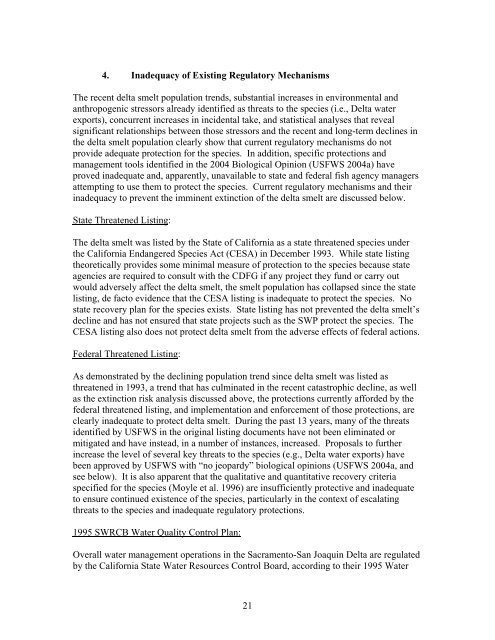ESWR page - Endangered Species & Wetlands Report
ESWR page - Endangered Species & Wetlands Report
ESWR page - Endangered Species & Wetlands Report
Create successful ePaper yourself
Turn your PDF publications into a flip-book with our unique Google optimized e-Paper software.
4. Inadequacy of Existing Regulatory Mechanisms<br />
The recent delta smelt population trends, substantial increases in environmental and<br />
anthropogenic stressors already identified as threats to the species (i.e., Delta water<br />
exports), concurrent increases in incidental take, and statistical analyses that reveal<br />
significant relationships between those stressors and the recent and long-term declines in<br />
the delta smelt population clearly show that current regulatory mechanisms do not<br />
provide adequate protection for the species. In addition, specific protections and<br />
management tools identified in the 2004 Biological Opinion (USFWS 2004a) have<br />
proved inadequate and, apparently, unavailable to state and federal fish agency managers<br />
attempting to use them to protect the species. Current regulatory mechanisms and their<br />
inadequacy to prevent the imminent extinction of the delta smelt are discussed below.<br />
State Threatened Listing:<br />
The delta smelt was listed by the State of California as a state threatened species under<br />
the California <strong>Endangered</strong> <strong>Species</strong> Act (CESA) in December 1993. While state listing<br />
theoretically provides some minimal measure of protection to the species because state<br />
agencies are required to consult with the CDFG if any project they fund or carry out<br />
would adversely affect the delta smelt, the smelt population has collapsed since the state<br />
listing, de facto evidence that the CESA listing is inadequate to protect the species. No<br />
state recovery plan for the species exists. State listing has not prevented the delta smelt’s<br />
decline and has not ensured that state projects such as the SWP protect the species. The<br />
CESA listing also does not protect delta smelt from the adverse effects of federal actions.<br />
Federal Threatened Listing:<br />
As demonstrated by the declining population trend since delta smelt was listed as<br />
threatened in 1993, a trend that has culminated in the recent catastrophic decline, as well<br />
as the extinction risk analysis discussed above, the protections currently afforded by the<br />
federal threatened listing, and implementation and enforcement of those protections, are<br />
clearly inadequate to protect delta smelt. During the past 13 years, many of the threats<br />
identified by USFWS in the original listing documents have not been eliminated or<br />
mitigated and have instead, in a number of instances, increased. Proposals to further<br />
increase the level of several key threats to the species (e.g., Delta water exports) have<br />
been approved by USFWS with “no jeopardy” biological opinions (USFWS 2004a, and<br />
see below). It is also apparent that the qualitative and quantitative recovery criteria<br />
specified for the species (Moyle et al. 1996) are insufficiently protective and inadequate<br />
to ensure continued existence of the species, particularly in the context of escalating<br />
threats to the species and inadequate regulatory protections.<br />
1995 SWRCB Water Quality Control Plan:<br />
Overall water management operations in the Sacramento-San Joaquin Delta are regulated<br />
by the California State Water Resources Control Board, according to their 1995 Water<br />
21
















